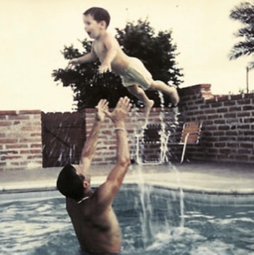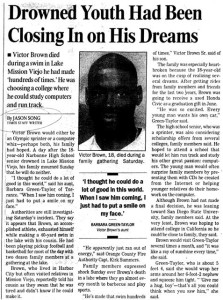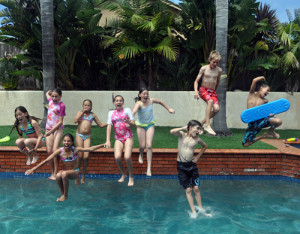Drowning Is A Silent Killer. Here are our annual summer water safety tips (pools, spas, lakes, rivers and oceans)
The 19-Month-Old Daughter of Olympic Skier, Bode Miller, Drowns in Pool
A drowning tragedy can happen in seconds. Lisa and I are parents and we both grew up with swimming in pools in the summer and also spending our winters snow skiing. When we saw this story on the news, our hearts sank.
The Bode Miller accident happened just down the street from where we live in Orange County. Everyone is in shock! This tragic story reminded us to share with everyone, facts behind the silent and deadly killer of drowning and, how you can protect your family.
Drowning is a Fast and Silent Killer!
 Lisa and I were both fortunate to grow up with swimming pools and spend time on the water at local lakes and beaches. We appreciate how much fun swimming and water sports can be, especially on a hot summer day.
Lisa and I were both fortunate to grow up with swimming pools and spend time on the water at local lakes and beaches. We appreciate how much fun swimming and water sports can be, especially on a hot summer day.
Here’s a picture of me being tossed by my dad way back in the day at the Saddle and Surrey Ranch in Tucson, Arizona. I’d like to think that to this day, I still show the same level of enthusiasm on my face when I answer ready for a jury trial :-)
With Summer just around the corner, we think it’s important for you to know how dangerous swimming in a pool, spa, ocean, lake and river, can be and what steps can be taken to avoid injuries and drownings. The Orange County, California, drowning cases we’ve helped families with over the past three decades were the motivation behind this post. Hopefully, this information will help save lives.
A Tragic Drowning Case
Most people are not aware of the deadly fact that drownings happen quickly, are usually silent, and can happen to anyone. We’ve represented very good and responsible Orange County families who have tragically lost children to drownings in a backyard pools, Jacuzzis, and public lakes. Without exception, they never saw the tragic drowning coming.
Before we share specific safety tips, we want to share the facts of a case we handled just a few years ago involving of an 18-year-old high school senior, and sport star, who drowned in Lake Mission Viejo. A family lost a beautiful son and brother who was in excellent shape, a high school track start, and in the prime of his life.
 In fact, this young man was so talented and such a good athlete that he was on his way to college on a full track scholarship. At the time of his death, the victim was swimming with friends and with lifeguards present.
In fact, this young man was so talented and such a good athlete that he was on his way to college on a full track scholarship. At the time of his death, the victim was swimming with friends and with lifeguards present.
Here’s how his death happened. While swimming out to a floating dock on the lake, our client’s son experienced severe cramping. His cousin who was swimming near him saw the young man raise his hands for a moment and then within 10-20 seconds, sink under the water. There was no sound.
The lifeguards failed to pay attention and were not even aware their was a problem despite the victim’s cousin screaming for help (unlike the movies, in real life most drowning victims don’t scream- more on this below).
This particular loss raised our awareness of just how quickly a drowning can take place and how it can happen to anyone. Drowning tragedies can happen even when lifeguards are in the area. It truly is a silent and fast death!
Here Are The Facts In Pool Related Drownings
Submersion incidents involving children usually happen in familiar surroundings. Statistics show that when it comes to pool drownings, sixty-five percent of the drowning accidents happen in a pool owned by the child’s family and 33 percent of the incidents happen in a pool owned by friends or relatives.
Seventy-five percent of the submersion victims studied by CPSC were between 1 and 3 years old; 65 percent of this group were boys. It is noted that toddlers, in particular, often do something unexpected because their capabilities change daily. This is a factor in the high number.
Most victims were being supervised by one or both parents
Forty-six percent of drowning victims were last seen in the house; 23 percent were last seen in the yard or on the porch or patio; and 31 percent were in or around the pool before the accident. In all, 69 percent of the children were not expected to be at or in the pool, yet they were found in the water.
Pool submersions involving children happen quickly. A child can drown in the time it takes to answer a phone. Seventy-seven percent of the victims had been missing from sight for 5 minutes or less.
Survival depends on rescuing the child quickly and restarting the breathing process. Seconds count in preventing death or brain damage.
Child drowning is a silent death. There’s no splashing to alert anyone that the child is in trouble.
 Safety Steps
Safety Steps
Watch All Swimmers– Regardless of where you are swimming, keep a close lookout on everyone in the water. [Fun story- this picture taken many years ago is of our son (front right) and his now high school friends who just graduated last week].
Use Barriers– Please note that the following barrier recommendations are the result of identifying key parameters that typically contribute to child drowning in backyard pools. These recommendations are the minimum steps you can take to make your home a safe place for your child. Barriers are not childproof, but they provide layers of protection for a child who strays from supervision. Barriers can give parents additional time to locate a child before the unexpected becomes a reality. Barriers include a fence or wall, door alarms for the house, and a power safety cover over the pool. Barriers also may be used to protect children from accessing hot tubs and spas. Use the following recommendations as a guide.
Fences and Gates– Install a fence or other barrier, such as a wall, completely around the pool. If the house is part of the barrier, the doors leading from the house to the pool should be protected with an alarm or the pool should have a power safety cover. Alarm and cover details are below.
The fence or other barrier should be at least 4 feet high. It should have no foot or handholds that could help a young child to climb it. Vertical fence slats should be less than 4 inches apart to prevent a child from squeezing through.
Use this as a guide when the release mechanism is located less than 54 inches from the bottom of the gate. If horizontal members are equal to or more than 45 inches apart, vertical spacing shall not exceed 4 inches. If the fence is chain link, then no part of the diamond-shaped opening should be larger than 1-3/4 inches. Fence gates should be self-closing and self-latching. The gate should be well maintained to close and latch easily. The latch should be out of a child’s reach.
When the release mechanism of the self-latching device is less than 54 inches from the bottom of the gate, the release mechanism for the gate should be at least 3 inches below the top of the gate on the side facing the pool. Placing the release mechanism at this height prevents a young child from reaching over the top of a gate and releasing the latch. Also, the gate and barrier should have no opening greater than 1/2 inch within 18 inches of the latch release mechanism. This prevents a young child from reaching through the gate and releasing the latch.
There are a wide variety of fencing construction materials available to compliment your house and pool surroundings. Your local fence company or pool enclosure company can provide you with information and assist you in making a selection.
The weak link in the strongest and highest fence is a gate that fails to close and latch completely. For a gate to close completely every time, it must be in proper working order.
Door Alarms– If the house forms one side of the barrier, then doors leading from the house to the pool should be protected with alarms that produce an audible sound when a door is unexpectedly opened. Install an alarm that can be temporarily turned off by an adult for a single opening of the door by using a keypad or switch that is out of a child’s reach.
Battery and electrically powered alarms are available. The key pad switch can be used by adults who wish to pass through the door without setting off the alarm. It should be placed high on all doors leading from the house to the pool. Affordable and easily installed alarms are available. An alarm signal immediately tells a parent that a door has been opened.
Power Safety Covers– Power safety covers over the pool may be used as an alternative to door alarms. A power safety cover should meet the requirements of the ASTM pool cover standard which addresses labeling requirements and performance. ASTM requires that a cover withstand the weight of two adults and a child to allow a rescue should an individual fall onto the cover. The standard also requires quick removal of water from the cover. A young child can drown in just inches of water.
A power safety cover is a motor powered barrier that can be placed over the water area. Motor-driven covers easily open and close over the pool. When the power safety cover is properly in place over the pool, it provides a high level of safety for children under 5 years old by inhibiting their access to the water.
Above Ground Pools– Steps and ladders leading from the ground to the pool should be secured and locked, or removed when the pool is not in use.
More Rules for Pools…
- Instruct babysitters about potential pool hazards to young children and about the use of protective devices, such as door alarms and latches. Emphasize the need for constant supervision.
- Never leave a child unsupervised near a pool. During social gatherings at or near a pool, appoint a “designated watcher” to protect young children from pool accidents. Adults may take turns being the “watcher.” When adults become preoccupied, children are at risk.
- If a child is missing, check the pool first. Seconds count in preventing death or disability. Go to the edge of the pool and scan the entire pool, bottom and surface, as well as the pool area.
- Do not allow a young child in the pool without an adult.
- Do not consider young children to be drown proof because they have had swimming lessons. Children must be watched closely while swimming.
- Do not use flotation devices as a substitute for supervision.
- Learn CPR (cardiopulmonary resuscitation). Babysitters and other caretakers, such as grandparents and older siblings, should also know CPR.
- Keep rescue equipment by the pool. Be sure a telephone is poolside with emergency numbers posted nearby.
- Remove toys from in and around the pool when it is not in use. Toys can attract young children to the pool.
- Never prop open the gate to a pool barrier.